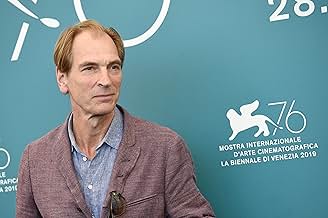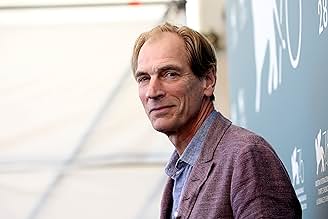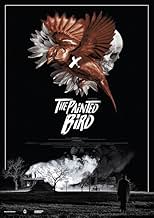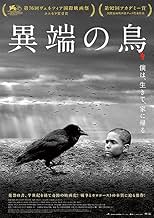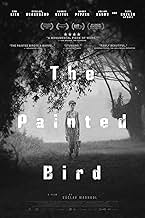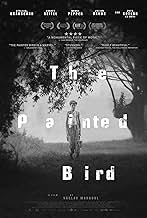CALIFICACIÓN DE IMDb
7.3/10
8.3 k
TU CALIFICACIÓN
Un joven judío busca refugio durante la Segunda Guerra Mundial, donde se encuentra con muchos personajes diferentes.Un joven judío busca refugio durante la Segunda Guerra Mundial, donde se encuentra con muchos personajes diferentes.Un joven judío busca refugio durante la Segunda Guerra Mundial, donde se encuentra con muchos personajes diferentes.
- Dirección
- Guionistas
- Elenco
- Premios
- 24 premios ganados y 24 nominaciones en total
Nina Sunevic
- Marta
- (as Nina Shunevych)
Marika Sarah Procházková
- Woman #1
- (as Marika Procházková)
Opiniones destacadas
It's an eastern european movie at its core: raw, uncompromising, brutal, dim, hopeless and honest.
Brutality actually lead to several people leaving the screening I attended to at Venice 76. Here, this movie was labeled as '14+' but I believe it can be easily rated NC-17. The brutality of this movie includes some very graphic gore (although it's mostly present in the first half of the movie) and sexual-related violence (mostly implied but persistent throughout the film). I believe that, as of on-screen depiction of violence, this film probably outranks Schindler's List (although It isn't as vast scaled as Spielberg's film).
Stylistically, this film uses mostly the visual medium rather than conversations to provide information to the viewer. Dialogue becomes secondary at a point where the main character maybe utters a couple of lines throughout the movie, and some of the characters he meets with are entirely silent (Skasgard's character, for example).
The film has a very precise structure: it is made up of 8 chapters, each entitled after a character that the kid meets with, and each chapter reaches a moment when the screen fades to black. After that, a sort-of connective sequence displays the events that lead the kid to change his whereabouts. Among the characters he meets, the audience might recognize Alexander Skasgard, but also Harvey Keitel (in an entirely czech-speaking role) as well as Barry Pepper and german actor Udo Kier.
I wouldn't say that The Painted Bird is a holocaust or ww2 movie, or better, it isn't only that. Thematic elements that relate to either the Holocaust or the War, with the exception of a german plane seen early on, come up only after around one hour in-movie. Before that, whatever happens is mostly related to a strongly rural and superstitious society.
The Painted Bird pays implicit homage to several Eastern European films. The opening sequence mimics the one seen in Jan Nemec's "Diamonds of the Night", a lot of settings remind Elem Klimov's "Come and See" and Tarkovsky's "Ivan's Childhood", the overall fatalist tone reminds strongly of Bela Tarr's films.
It is an outstanding accomplishment, and I sincerely hope that this movie, despite its graphic content, receives enough recognition.
Brutality actually lead to several people leaving the screening I attended to at Venice 76. Here, this movie was labeled as '14+' but I believe it can be easily rated NC-17. The brutality of this movie includes some very graphic gore (although it's mostly present in the first half of the movie) and sexual-related violence (mostly implied but persistent throughout the film). I believe that, as of on-screen depiction of violence, this film probably outranks Schindler's List (although It isn't as vast scaled as Spielberg's film).
Stylistically, this film uses mostly the visual medium rather than conversations to provide information to the viewer. Dialogue becomes secondary at a point where the main character maybe utters a couple of lines throughout the movie, and some of the characters he meets with are entirely silent (Skasgard's character, for example).
The film has a very precise structure: it is made up of 8 chapters, each entitled after a character that the kid meets with, and each chapter reaches a moment when the screen fades to black. After that, a sort-of connective sequence displays the events that lead the kid to change his whereabouts. Among the characters he meets, the audience might recognize Alexander Skasgard, but also Harvey Keitel (in an entirely czech-speaking role) as well as Barry Pepper and german actor Udo Kier.
I wouldn't say that The Painted Bird is a holocaust or ww2 movie, or better, it isn't only that. Thematic elements that relate to either the Holocaust or the War, with the exception of a german plane seen early on, come up only after around one hour in-movie. Before that, whatever happens is mostly related to a strongly rural and superstitious society.
The Painted Bird pays implicit homage to several Eastern European films. The opening sequence mimics the one seen in Jan Nemec's "Diamonds of the Night", a lot of settings remind Elem Klimov's "Come and See" and Tarkovsky's "Ivan's Childhood", the overall fatalist tone reminds strongly of Bela Tarr's films.
It is an outstanding accomplishment, and I sincerely hope that this movie, despite its graphic content, receives enough recognition.
I had already read the 1965 novel THE PAINTED BIRD, and it most certainly stuck with me, so when I heard a film adaptation was coming out, I HAD to see it. I'm not sure if any of you have seen Asia Argento's film adaptation of JT Leroy's THE HEART IS DECEITFUL ABOVE ALL THINGS (starring the Sprouse twins) - this is basically the same movie, only it takes place with a Jewish boy during World War II rather than during contemporary times in America. It's like that movie at it's core but then mixed the aesthetics and vibes of, like, Schindler's List, and sometimes it even feels a bit like The Witch. In summary, it's about an orphaned boy wandering aimlessly trying to find a proper caretaker for himself but every single adult who takes him in is an evil person who abuses the child one way or another. Clearly, the relentlessness of the subject matter and the commitment to world-building entirely around it causes a lot of people (most people really) to despise both of these movies. However, it is clear to me that these were created as cathartic pieces of art - though it's doubtful that this ever happened this relentlessly to any child, by so many different people, it is POSSIBLE, but that's irrelevant because the film functions as a surrealist interpretation of the aloneness, the helplessness, and the inescapable claustrophobia that some children do feel as they struggle to find the footing in their developmental existence. The 3-hour runtime does cause the film to feel a bit redundant at points, but that's really the movie's only flaw, and in the end it's a rewarding viewing - all of the performances are dynamic, brave, and many of them are frightening or at the very least jarring. There are are small roles from Harvey Keitel, Barry Pepper, and a very important actor to me, Julian Sands - in probably his creepiest appearance ever. The environments and cinematography are both impressive - gorgeous but effectively bleak to match the tone. What it comes down to is that this is a beautiful film about the ugliest thing. It's not for everyone - just looks at the reviews, you could say "people hate it" - that's what the reviews show, but the truth is there is a lot to marvel at and praise here. People just can't handle certain levels of darkness in art. The most interesting part of all of this is that both books THE HEART IS DECEITFUL ABOVE ALL THINGS and THE PAINTED BIRD were originally marketed as autobiographical memoirs when they found success, then both were shunned when it was revealed that they were actually entirely fictional. THE PAINTED BIRD is the original HEART IS DECEITFUL - I just never realized it until now. Take from that what you will.
Heavy. It's a series of chapters displayed by a photography both stunning and merciless. Human beings here are foundamentally cruel (with a couple of exceptions) and cruelty flows from the oppressor to the oppressed. The movie reminds us about that.
The ending has being discussed, but I think that, just maybe, the protagonist can still hope for a better future.
A young Jewish boy and the extreme abuse (quite hideous, alarming at times) and suffering inflicted upon him during WWII by some exceptionally evil and wicked people; slightly loses traction with a few too many frying pan fire cycles to emphasise the point, a shocking experience nonetheless, albeit a very long one. Whether the world still needs this kind of stylisation of the effects of war remains debatable, as does its impact on the memories and emotions already formed over so many years and by so many.
This is like a gift giver that just keeps on giving. Never once throughout the almost three hour run time was I bored. I was captivated from the very first minute right up until the final fade out.
We follow a young Jewish boy trying to survive amidst the chaos of World War II. His luck is horrible and he is subjected to a series of abuses and abusers.
Stay with him, the Painted Bird pays off and will linger in your mind long after you've seen it.
9/10
We follow a young Jewish boy trying to survive amidst the chaos of World War II. His luck is horrible and he is subjected to a series of abuses and abusers.
Stay with him, the Painted Bird pays off and will linger in your mind long after you've seen it.
9/10
¿Sabías que…?
- TriviaIn the 1960s, writer Jerzy Kosinski had become famous in Manhattan literary circles for his astonishing tales about the brutalities he had allegedly suffered during the Second World War. Abandoned by his parents at the age of six, he claimed he had roamed the countryside alone, witnessing rape, murder, and incest, constantly fearing for his life. Kosinski turned those stories into his first novel, "The Painted Bird", which, for a time, was considered a major work of Holocaust literature. Kosinski's claims were later debunked when it was revealed that he and his parents had all been sheltered by religious Poles who had never handed him over to the Nazis.
- ErroresAfter the old man died, Lubina rolled him face down in his grave. The next shot he lies face up.
- ConexionesFeatured in CT na MFF Karlovy Vary 2019: Nabarvené ptáce (2019)
- Bandas sonorasFür Elise
Music by Ludwig van Beethoven
Selecciones populares
Inicia sesión para calificar y agrega a la lista de videos para obtener recomendaciones personalizadas
- How long is The Painted Bird?Con tecnología de Alexa
Detalles
- Fecha de lanzamiento
- Países de origen
- Sitios oficiales
- Idiomas
- También se conoce como
- Painted Bird
- Locaciones de filmación
- Productoras
- Ver más créditos de la compañía en IMDbPro
Taquilla
- Presupuesto
- CZK 175,000,000 (estimado)
- Total en EE. UU. y Canadá
- USD 1,460
- Fin de semana de estreno en EE. UU. y Canadá
- USD 452
- 19 jul 2020
- Total a nivel mundial
- USD 659,535
- Tiempo de ejecución2 horas 49 minutos
- Color
- Mezcla de sonido
- Relación de aspecto
- 2.39 : 1
Contribuir a esta página
Sugiere una edición o agrega el contenido que falta

Principales brechas de datos
What is the streaming release date of The Painted Bird (2019) in Australia?
Responda



